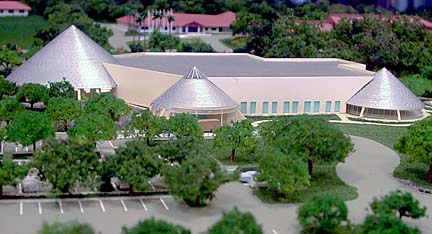
The Mauna Kea Astronomy Education Center, dedicated yesterday at the University of Hawaii at Hilo, will have three cones that represent Mauna Kea, Mauna Loa and Hualalai, as shown in the model. Construction is expected to be completed by late fall of next year.
Astronomy center
takes shapeThe UH-Hilo facility focuses
on education but will be available
for private light shows
HILO >> Putting together an education center that combines Hawaiian culture nearly 2,000 years old and astronomical studies reaching back 12 billion years is not easy.
When biology professor Marlene Hapai first thought of the project in 1993, as the sugar industry folded in her hometown of Honokaa, she imagined only a science education center to fill the void in the Big Island community's life.
But as time passed, the concept changed to include Hawaiians voyaging across the Pacific as well as astronomers using their telescopes to study the stars.
Yesterday, 11 years after Hapai spent her 1993 Christmas vacation putting the original idea together, Sen. Daniel Inouye and others dedicated the Mauna Kea Astronomy Education Center at the University of Hawaii at Hilo.
Under construction since February, the 40,000-square-foot center is scheduled for completion late next year. Inouye said the funding included $23 million to date, mostly from the National Aeronautics and Space Administration, and $6 million to come.
Additional time will be needed to install exhibits, said Hapai, who returned to Hilo in January to complete the project after several years at the UH-Manoa campus.
The finished center will feature a 120-seat planetarium, which will have the most world's most up-to-date laser projection of stars.
The same lasers can also be used to put on a starry "light show" for any group that wants to put on a special birthday party, for instance, Hapai said. "With this laser you can do anything because it's run by computer," she said.
The birthday party idea arises from the fact that the center will have to earn its own money. Hapai does not think that will be hard. She expects attendance of 100,000 a year, including cruise ship passengers.
Besides the planetarium, the center will have exhibits showing the astronomical idea of the origin of the universe in a "big bang." Other exhibits will illustrate the Hawaiian view of the origin of the universe called the Kumulipo, the origins out of the "blue black."
Hapai's original science idea started to be linked to a Hawaiian cultural component when she talked to Inouye's staff in 1995, she said.
"We need something like this," Inouye said yesterday. "A people will become successful only when they have pride in themselves."
